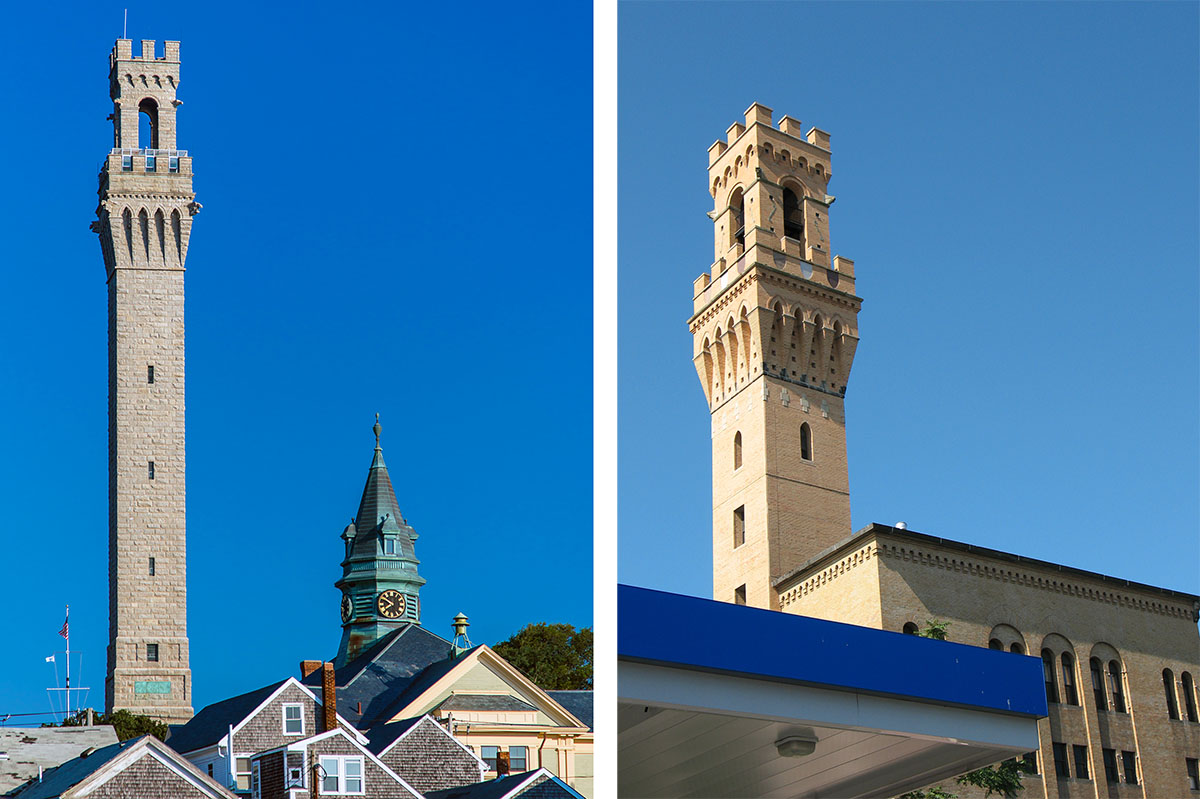Throwback Thursday: How Two Massachusetts Towers Became Twins

Pilgrim Monument photo by Mark Kortum on Flickr and Pine Street Inn photo by Aaron Knox on Flickr.
The South End’s iconic Pine Street Inn has a twin.
The yellowish brick structure with its protruding tower looks pretty similar to another one on the Cape. That’s because it’s almost the same in design as the Pilgrim Monument in Provincetown, only smaller. Both towers share an open arch with seven mini-turrets and a row of four corbeled arches on each side of the crown.
The Pine Street Inn building at 444 Harrison Ave. was first used as the Fire Department Headquarters for Boston, and at the time, was located at 60 Bristol St. After the Great Fire of 1872, which destroyed nearly all of the downtown area, a nervous city decided to build a lookout tower to spot fires. The firehouse and its tower were built in 1893, and were designed by famed architect Edmund M. Wheelwright.
So how did a strikingly similar tower end up in Provincetown?
It’s unlikely that a wealthy Cape Cod enthusiast decided to bring his favorite vacation spot to the city. The Pilgrim Monument in Provincetown was actually built in 1910, 17 years after the South End tower was constructed. And it was designed by a completely different guy—another famous architect from Boston named Willard T. Sears. But Sears isn’t a copycat, even if it seems that way.
Both towers were modeled after the Torre Del Mangia in Siena, Italy, although they look more similar to each other than they do to the Torre Del Mangia.

Torre Del Mangia | Photo by Il Tesoro di Siena on Flickr.
Sears was already a renowned architect of his day. Why would he would model the Pilgrim Monument after the Torre Del Mangia, even though Wheelwright had already done similar work? According to Dennis DeWitt, an architectural historian, Wheelwright expert, and author of Modern Architecture in Europe, it’s impossible that Sears didn’t know about the fire tower’s design.
“Everyone knew the fire tower,” DeWitt says. “I’m sure it was the most prominent thing on the skyline.”
At the time the fire tower was built, there was a height limit for buildings in Boston—they couldn’t soar more than 125 feet above sea level. The first exception to this rule was the Customs House tower, and the second was the Bristol Street fire tower. So not only did Sears know about the fire tower, but he knew Wheelwright, too.
“There’s no question that they knew each other,” says DeWitt.
Consider that Sears harbored a personal vendetta against Wheelwright. After all, Sears was 73 years old when he built the Pilgrim Monument. He could have felt threatened by the younger Wheelwright, who was 56 at the time. Sears had the Isabella Stewart Gardner Museum and the Old South Church under his belt, but Wheelwright was thriving. He became famous for designing the Longfellow Bridge and Horticultural Hall, as well as aiding in the design of the Boston Public Library. He was also a consulting architect for the Museum of Fine Arts.
DeWitt explains Sears wasn’t jealous or a copycat—he was a talented architect all on his own.
“He wouldn’t have needed to work from Wheelwright to create something,” he says. “He probably made a few adjustments, but both towers were very closely copied from the tower in Siena.”
This doesn’t mean that the citizens didn’t make the connection. Architects expressed surprise at the outcome of the contest that was held to design the Pilgrim Monument. Over 150 submissions were received, and some people were critical of the final choice. The Boston Daily Globe detailed the issue in an article from January 1907:

photo via Boston Globe Archives
The design…is simply a copy of the tower of the city hall or communal building of the city of Siena in Italy… A very good copy of this same tower may be seen right here in Boston on the central fire station on Bristol St., and, like the original, is built of brick.
Why this old tower of the late Gothic period in Tuscany should be selected as a model for the memorial to the Pilgrim Fathers down on Cape Cod puzzles the architects of this city, one of whom said:
“If all they want is an architectural curiosity, why not select the Leaning Tower of Pisa and be done with it. That would attract more attention on Cape Cod than the Tower del Mangia of Siena, which by the way, has always been regarded as a bit of a civic architecture, although it is undoubtedly a very beautiful tower. It doesn’t look at all out of place, for instance, as a feature of the central fire station which Wheelwright designed for Boston. But here again it has a civic purpose, and a good one. I question its propriety, however, as a memorial to the Pilgrim fathers.”
As years have passed and Boston’s skyline has dramatically changed, it seems that the Pilgrim Monument has become much more well-known than the city’s first fire tower. Willard Sears, possibly unknowingly, stole Edmund Wheelwright’s thunder—even to the extent that some people believe the South End’s old fire tower was modeled after the Pilgrim Monument. This, of course, just isn’t so.


